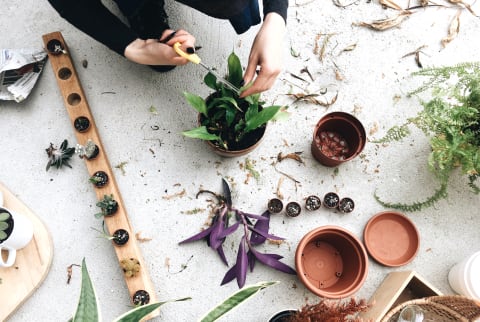Advertisement
Fertilizer 101: How To Use It For Healthier, Happier Houseplants


When houseplants are nestled in fresh soil, they're surrounded by all the essential nutrients they need to grow. Over time, though, the plant's roots will absorb a lot of those nutrients and use them up via photosynthesis. That's where fertilizers come in: They replenish lost nutrients so your plants can grow stronger, longer leaves, roots, and flowers.
Your indoor greenery can probably survive without fertilizer (as long as it gets adequate water and sunlight), but adding it can help plants really thrive.
Here, horticulture experts share their take on the best fertilizers to buy and DIY and walk through how to use them.
What is fertilizer & what does it do?
Fertilizers contain essential nutrients a plant needs to grow—the most important being nitrogen (N), phosphorus (P), and potassium (K).
"In general, nitrogen is the be-all and end-all of nutrients," Jonathan Russell-Anelli, Ph.D., a senior lecturer in Cornell's School of Integrative Plant Science, tells mbg. "It is generally the most limiting, and it is needed in abundance and is often needed quickly. P and K also are often required beyond the soil's ability to meet immediate needs."
Beyond that, plants use sulfur (S), magnesium (Mg), carbon (C), oxygen (O), hydrogen (H), and very small amounts of iron (Fe), boron (B), chlorine (Cl), manganese (Mn), zinc (Zn), copper (Cu), and molybdenum (Mo).
"Plants combine these nutrients with sunlight, air, and water to make their own food through the process of photosynthesis," Leslie F. Halleck, M.S., a certified professional horticulturist and author, explains.
You'll typically see three numbers on your fertilizer label, which speak to its ratio of nitrogen, phosphorous, and potassium. If yours reads 24-8-16, for example, it has 24% N, 8% P, and 16% K by weight, and potentially some of those micronutrients. Water and/or fillers make up the rest of the weight.
Types of fertilizers.
Nitrogen, the workhorse nutrient, supports the growth of the plant's leaves while phosphorous helps out with root growth and flowering. Potassium assists with all-around plant health.
Houseplants that have fewer leaves, like succulents, require less nitrogen, which is why you might find a succulent-specific fertilizer at a 5-10-10 ratio, for example.
Flowering houseplants, on the other hand, might appreciate a higher P value. All in all, though, most houseplants will be happy with a fertilizer that has an even ratio of all three, making this a good starter pick.
The most common fertilizer types are liquid fertilizers, which you can use directly on a plant, and granular ones that need to be dissolved in water.
You can also find slow-release fertilizers that need to be applied only once every few months, but this option gives you less control over how much fertilizer your plants are actually getting.
Organic vs. synthetic.
Just like human food, fertilizer comes in organic and non-organic varieties. The difference is that one is made from natural material and the other is produced in a lab.
Synthetic fertilizers tend to have higher percentages of nutrients than natural ones and should therefore be applied more judiciously. If you add too much of them to a plant, its leaves can burn and its soil can develop salt buildups due to all those extra nutrients.
That's why Halleck opts for organic fertilizer whenever possible: "That includes liquid humus, composted manures, seaweed, etc., for my houseplants," she says. These fertilizers more closely mimic the nutrients a plant would receive in its natural habitat and tend to be gentler—though they are usually more expensive.
Homemade fertilizers.
Making your own fertilizer, or "plant food", is a popular way to give houseplants a dose of natural nutrients on the cheap.
You might have heard of people sprinkling coffee grounds, eggshells, salt, or banana peels onto their plant pals. However, Russell-Anelli warns that most of these kitchen DIYs are "generally based on garden folklore and can quickly damage gardens if not understood and used correctly."
"Uncomposted kitchen scraps in your potting soil can also cause fungal or bacterial problems in your soil, as well as fungus gnat problems," warns Halleck.
That's not to say that your kitchen scraps can't be repurposed as plant food; you just might want to compost or vermicompost them first to make their nutrients more readily available. "Essentially, any organic matter can be composted down into ingredients for natural plant fertilizers," says Halleck.
Learn all about what can and can't be composted at home here. Russell-Anelli adds that green veggie scraps and grass clippings are particularly good for houseplant-bound compost since they're high in nitrogen. (Remember, nitrogen corresponds with leaves and all things green!).
Once your compost is good to go, you can add it directly to soil until it makes up around 10 to 20% of your plant's pot by volume. (You won't want to go higher than that since it can attract pests and diseases, Halleck explains.) You can also soak it in water to make your own "compost tea"—essentially a more nutrient-dense, liquid form of compost.
Your plants might actually enjoy some actual tea every now and again, too. "Twice-brewed green tea can offer a small amount of soluble nutrients and possibly a slight acidifying effect (if used repeatedly), when used to directly water your plants," says Halleck.
"But do not expect your plants to green up quickly or significantly from green tea. I typically only use leftover green tea for my plants. Be sure to compost the used tea leaves after you have brewed them."
How to use fertilizer.
Halleck and Russell-Anelli both say that the golden rule of plant fertilization is to not overapply—especially if you're using a synthetic fertilizer.
"If you do use synthetic fertilizers, I recommend cutting the application rate in half," says Halleck. Every type of fertilizer will come with its own application instructions, so look out for those on the box or bottle. "For tiny houseplants, cut the application rate down to ¼ of the recommended rate, even with natural fertilizers."
As for when to use fertilizer, your plants won't need it for the first two months or so in new soil. After that, most plant experts say to fertilize once every two weeks to one month during your plant's active growing season, while you're watering your plant.
You might want to use even less fertilizer at the very beginning and end of growing season, as your plant won't be actively taking in as many nutrients.
Again, higher concentrations of N-P-K mean that a fertilizer will be more intense and should therefore be diluted in more water or used less frequently.
"When it comes to fertilizers, unless you know for certain, go with the less-is-more strategy and then wait at least a couple of days before adding more," Russell-Anelli recommends. Signs that you've overdone it include yellow leaves, salt buildup in soil, and leaf loss.
The bottom line.
Fertilizer replenishes vital soil nutrients your plant uses up during photosynthesis. You can buy natural and synthetic fertilizers, or make your own using composted kitchen scraps. Just be careful not to overdo it in the fertilizer department, as it can cause nutrient overload for your plants.
Watch Next
Enjoy some of our favorite clips from classes
Enjoy some of our favorite clips from classes
What Is Meditation?
Mindfulness/Spirituality | Light Watkins
Box Breathing
Mindfulness/Spirituality | Gwen Dittmar
What Breathwork Can Address
Mindfulness/Spirituality | Gwen Dittmar
The 8 Limbs of Yoga - What is Asana?
Yoga | Caley Alyssa
Two Standing Postures to Open Up Tight Hips
Yoga | Caley Alyssa
How Plants Can Optimize Athletic Performance
Nutrition | Rich Roll
What to Eat Before a Workout
Nutrition | Rich Roll
How Ayurveda Helps Us Navigate Modern Life
Nutrition | Sahara Rose
Messages About Love & Relationships
Love & Relationships | Esther Perel
Love Languages
Love & Relationships | Esther Perel

















